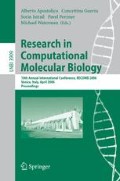Abstract
There is a resurgence of interest in RNA secondary structure prediction problem (a.k.a. the RNA folding problem) due to the discovery of many new families of non-coding RNAs with a variety of functions. The vast majority of the computational tools for RNA secondary structure prediction are based on free energy minimization. Here the goal is to compute a non-conflicting collection of structural elements such as hairpins, bulges and loops, whose total free energy is as small as possible. Perhaps the most commonly used tool for structure prediction, mfold/RNAfold, is designed to fold a single RNA sequence. More recent methods, such as RNAscf and alifold are developed to improve the prediction quality of this tool by aiming to minimize the free energy of a number of functionally similar RNA sequences simultaneously. Typically, the (stack) prediction quality of the latter approach improves as the number of sequences to be folded and/or the similarity between the sequences increase. If the number of available RNA sequences to be folded is small then the predictive power of multiple sequence folding methods can deteriorate to that of the single sequence folding methods or worse.
In this paper we show that delocalizing the thermodynamic cost of forming an RNA substructure by considering the energy density of the substructure can significantly improve on secondary structure prediction via free energy minimization. We describe a new algorithm and a software tool that we call Densityfold, which aims to predict the secondary structure of an RNA sequence by minimizing the sum of energy densities of individual substructures. We show that when only one or a small number of input sequences are available, Densityfold can outperform all available alternatives. It is our hope that this approach will help to better understand the process of nucleation that leads to the formation of biologically relevant RNA substructures.
Access this chapter
Tax calculation will be finalised at checkout
Purchases are for personal use only
Preview
Unable to display preview. Download preview PDF.
References
Mapping RNA Form & Function. Science 309(5740) (September 2, 2005)
RNA_align tool, http://www.csd.uwo.ca/faculty/kzhang/rna/
Akutsu, T.: Dynamic programming algorithms for RNA secondary structure prediction with pseudoknots. Discr. Appl. Math. 104(1-3), 45–62 (2000)
Arslan, A.N., Egecioglu, O., Pevzner, P.A.: A New Approach to Sequence Comparison: Normalized Sequence Alignment. In: Proc. RECOMB, pp. 2–11. ACM, New York (2001)
Bafna, V., Tang, H., Zhang, S.: Consensus Folding of Unaligned RNA Sequences Revisited. In: Miyano, S., Mesirov, J., Kasif, S., Istrail, S., Pevzner, P.A., Waterman, M. (eds.) RECOMB 2005. LNCS (LNBI), vol. 3500, pp. 172–187. Springer, Heidelberg (2005)
Condon, A., Davy, B., Rastegari, B., Zhao, S., Tarrant, F.: Classifying RNA pseudoknotted structures. Theor. Comput. Sci. 320(1), 35–50 (2004)
Davydov, E., Batzoglou, S.: A Computational Model for RNA Multiple Structural Alignment. In: GECCO 2004. LNCS, vol. 3103, pp. 254–269. Springer, Heidelberg (2004)
Gorodkin, J., Heyer, L., Stormo, G.: Finding the most significant common sequence and structure motifs in a set of RNA sequences. Nucl. Acids Res. 25(18), 3724–3732 (1997)
Griffiths-Jones, S., Bateman, A., Marshall, M., Khanna, A., Eddy, S.: Rfam: an RNA family database. Nucl. Acids Res. 31(1), 439–441 (2003)
Hofacker, I., Fekete, M., Stadler, P.: Secondary structure prediction for aligned RNA sequences. J. Mol. Biol. 319(5), 1059–1066 (2002)
Ji, Y., Xu, X., Stormo, G.D.: A graph theoretical approach for predicting common RNA secondary structure motifs including pseudoknots in unaligned sequences. Bioinformatics 20(10), 1591–1602 (2004)
Lin, G., Ma, B., Zhang, K.: Edit distance between two RNA structures. In: Proc. RECOMB, pp. 211–220. ACM, New York (2001)
Lyngso, R.B., Zuker, M., Pedersen, C.N.S.: Fast evaluation of internal loops in RNA secondary structure prediction. Bioinformatics 15(6), 440–445 (1999)
Ma, B., Wang, L., Zhang, K.: Computing similarity between RNA structures. Theoretical Computer Science 276(1-2), 111–132 (2002)
Mathews, D., Sabina, J., Zuker, M., Turner, D.: Expanded sequence dependence of thermodynamic parameters improves prediction of RNA secondary structure. J. Mol. Biol. 288(5), 911–940 (1999)
Mathews, D., Turner, D.: Dynalign: an algorithm for finding the secondary structure common to two RNA sequences. J. Mol. Biol. 317(2), 191–203 (2002)
Nussinov, R., Jacobson, A.: Fast algorithm for predicting the secondary structure of single stranded RNA. Proc. Nat. Acad. Sci. USA 77(11), 6309–6313 (1980)
Rivas, E., Eddy, S.R.: A dynamic programming algorithm for RNA structure prediction including pseudoknots. J. Mol. Biol. 285(5), 2053–2068 (1999)
Sankoff, D.: Simultaneous Solution of the RNA Folding, Alignment and Protosequence Problems. SIAM J. Appl. Math. 45, 810–825 (1985)
Thompson, J., Higgins, D., Gibson, T.: Clustal-W: improving the sensitivity of progressive multiple sequence alignment through sequence weighting, position specific gap penalties and weight matrix choice. Nucl. Acids Res. 22, 4673–4680 (1994)
Tinoco, I., Uhlenbeck, O., Levine, M.: Estimation of secondary structure in ribonucleic acids. Nature 230(5293), 362–367 (1971)
Zuker, M., Stiegler, P.: Optimal computer folding of large RNA sequences using thermodynamics and auxiliary information. Nucleic Acids Res. 9(1), 133–148 (1981)
Zuker, M.: On finding all suboptimal foldings of an RNA molecule. Science 244, 48–52 (1989)
Author information
Authors and Affiliations
Editor information
Editors and Affiliations
Rights and permissions
Copyright information
© 2006 Springer-Verlag Berlin Heidelberg
About this paper
Cite this paper
Alkan, C. et al. (2006). RNA Secondary Structure Prediction Via Energy Density Minimization. In: Apostolico, A., Guerra, C., Istrail, S., Pevzner, P.A., Waterman, M. (eds) Research in Computational Molecular Biology. RECOMB 2006. Lecture Notes in Computer Science(), vol 3909. Springer, Berlin, Heidelberg. https://doi.org/10.1007/11732990_12
Download citation
DOI: https://doi.org/10.1007/11732990_12
Publisher Name: Springer, Berlin, Heidelberg
Print ISBN: 978-3-540-33295-4
Online ISBN: 978-3-540-33296-1
eBook Packages: Computer ScienceComputer Science (R0)

